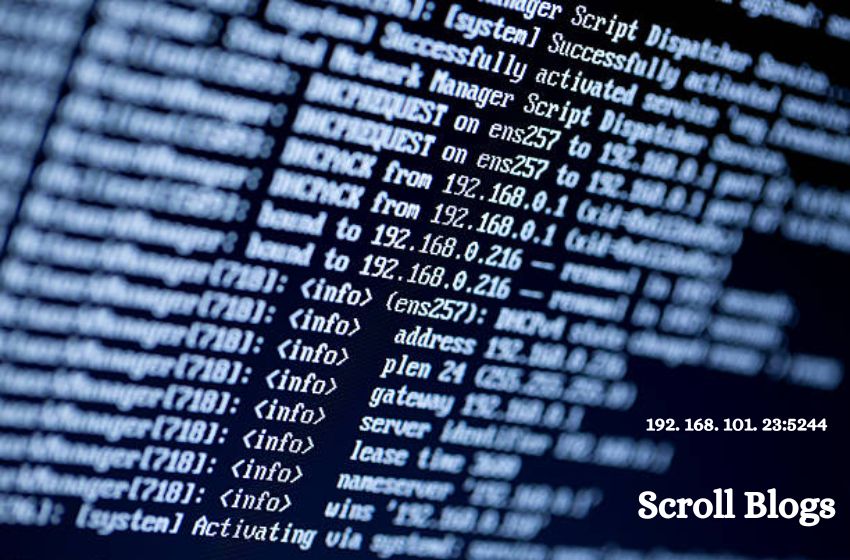In the realm of Networking and technology, certain numeric sequences often appear that may seem cryptic to the uninitiated. One such sequence is “192. 168. 101. 23:5244.” For those who work in IT or have an interest in computer networks, this might immediately ring a bell. However, for the average user, it can be confusing. This article will delve into the intricacies of what “192. 168. 101. 23:5244” signifies, breaking it down into understandable components and discussing its relevance in various contexts.
What is an IP Address?
Before diving into the specific details of “192. 168. 101. 23:5244,” it’s important to understand what an IP address is. IP stands for Internet Protocol, a set of rules that dictate how data is sent and received over the internet. An IP address is a unique string of numbers separated by periods, which identifies each computer using the Internet Protocol to communicate over a network.
Every device connected to the internet has an IP address. It’s akin to a postal address for your device, ensuring that the data sent over the internet reaches the correct destination. There are two types of IP addresses: IPv4 and IPv6. IPv4, which is what we see in “192. 168. 101. 23,” is the most commonly used, but due to the limited number of possible addresses, IPv6 is gradually being adopted.
Breaking Down “192. 168. 101. 23”
The IP address “192. 168. 101. 23” is a private IPv4 address. In networking terms, a private IP address is used within a local network and is not routable on the public internet. These addresses are reserved for private networks and are used to identify devices within that network.
The “192.168.x.x” range is one of the most common private IP ranges. Most home routers assign IP addresses in this range to devices on the local network. For example, your laptop might be assigned “192. 168. 101. 23” by your router when you connect to your home Wi-Fi.
Understanding the Significance of “:5244”
The second part of “192. 168. 101. 23:5244” is the “:5244” portion. This represents a port number. In networking, a port is a communication endpoint. When a device connects to another device over the internet, it typically does so through a specific port number, which directs the traffic to the appropriate service on the receiving device.
Port numbers range from 0 to 65535, and certain numbers are designated for specific services. For instance, port 80 is traditionally used for HTTP web traffic, while port 443 is used for HTTPS traffic. Port “5244” does not have a commonly assigned function, meaning it’s likely being used for a specific, perhaps custom, application on a network.
The Practical Application of “192. 168. 101. 23:5244”
Given that “192. 168. 101. 23:5244” is a combination of a private IP address and a port number, this sequence likely represents a specific service running on a device within a local network. For instance, it could refer to a server hosting a web application, a file-sharing service, or any other networked application that is accessible through that IP and port.
Within a local network, devices can communicate with each other using these IP addresses and ports. If a device on your network is running a service that listens on port 5244, another device on the same network could connect to that service using the address “192. 168. 101. 23:5244”.
Security Considerations
When dealing with IP addresses and ports, security is a crucial consideration. Because “192. 168. 101. 23” is a private IP address, it is not directly accessible from the internet, which provides a layer of security. However, if this address and port combination were exposed to the public internet, it could potentially be exploited by malicious actors.
One common security practice is to ensure that services running on a network are not only using secure ports but are also properly configured to prevent unauthorized access. For instance, if “192. 168. 101. 23:5244” were hosting a sensitive application, it would be wise to ensure that only authorized users on the local network can access it.
Common Use Cases and Examples
Let’s consider some practical scenarios where “192. 168. 101. 23:5244” might be used:
- Home Networking: Imagine you have a file server running on your local network, and it’s configured to listen on port 5244. You could access this server from another device on your network by entering “192. 168. 101. 23:5244” in your file-sharing application or web browser, depending on how the service is set up.
- Testing and Development: In a development environment, you might have various services running on different ports for testing purposes. A developer could use “192. 168. 101. 23:5244” to access a specific instance of an application they are working on, isolating it from other services running on different ports.
- Remote Desktop: If a remote desktop service were set up to run on port 5244, a user could connect to their desktop remotely using the IP address “192. 168. 101. 23:5244”. This setup is commonly seen in IT environments where different services need to be accessible from various devices within a local network.
Conclusion
In summary, “192. 168. 101. 23:5244” is more than just a random string of numbers; it’s a specific address and port combination within a private network. It points to a device at IP “192. 168. 101. 23” on a local network, with a service running on port “5244.” Whether for personal use, development, or small-scale enterprise networking, understanding this sequence can help in effectively managing and troubleshooting network services.
The key takeaway is that while these numbers may seem intimidating at first, they serve an essential function in network communication. By understanding what “192. 168. 101. 23:5244” represents, users can better navigate the complexities of their local networks and ensure secure and efficient operation of their connected devices.


